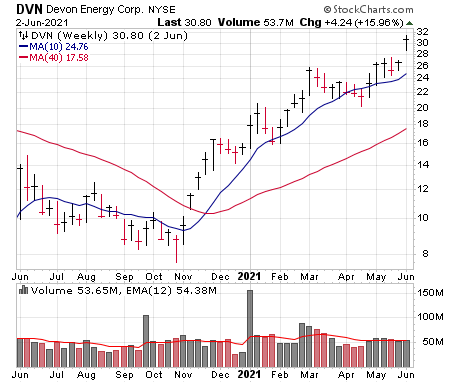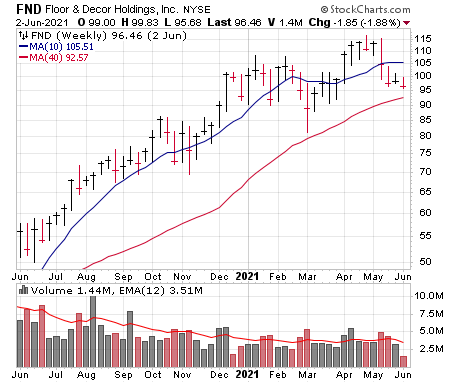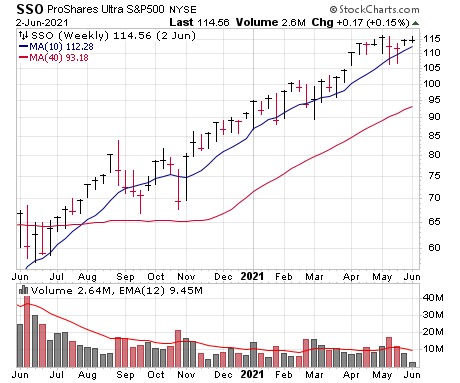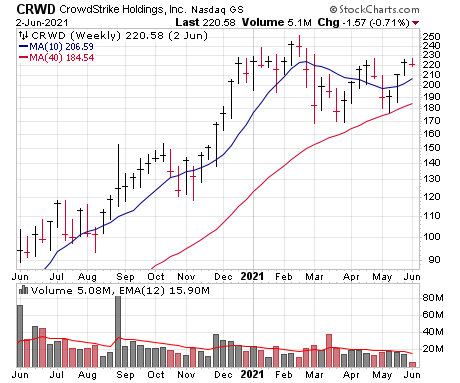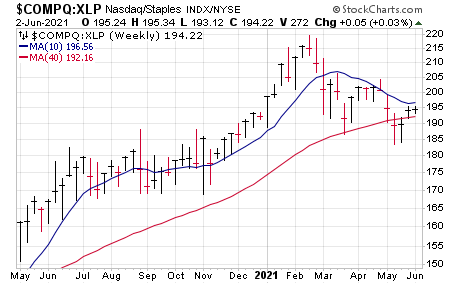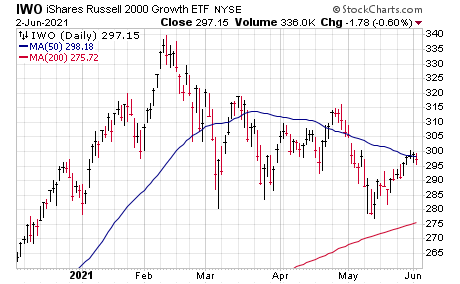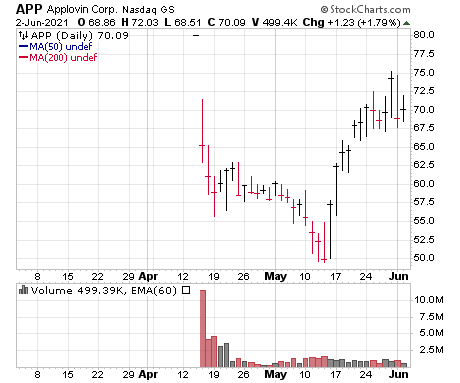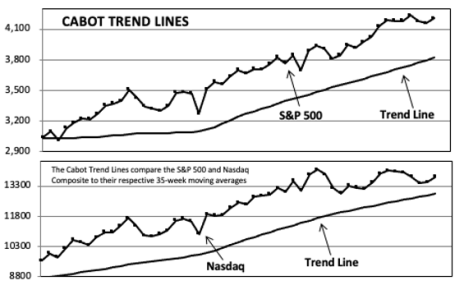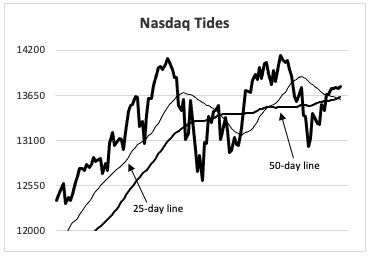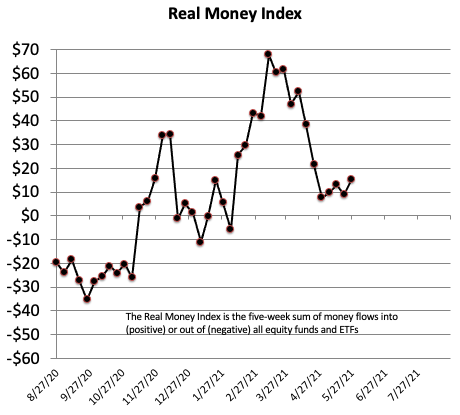Growth stocks have taken a series of small, positive baby steps during the past three weeks, which, given where things were at early last month, we’ll take. It’s been enough for us to put some money to work.
That said, the environment has a lot of room for improvement; we’re going slow, but will be happy to put more money to work if we see further progress. In the Model Portfolio, we’re averaging up in one of our stocks tonight, but that will still leave us with around 57% in cash.
Cabot Growth Investor 1473
[premium_html_toc post_id="231592"]
Baby Steps
Three weeks ago, growth stocks were in ruins, and we don’t think that’s much of an exaggeration—while the Nasdaq was only 8.5% off its high, things like the Russell 2000 Growth Fund (IWO), which we write about later in this issue, sat more than 18% off its peak while the glamour ARK Innovation Fund (ARKK) was off nearly 40% from its high-water mark.
Add to that the damage inflicted to so many growth stocks both before and after earnings season, and some type of immediate turnaround and blastoff was highly unlikely. We liken it to a runner who came down with a severely hurt (or broken) ankle—he or she wasn’t just going to get up a couple of days later and run a marathon. Instead, time is needed for the wounds to heal; in the market, that means time for the weak hands to get out and big investors to rebuild positions.
But with all of that in mind, the action since early May has been about as good as we could have hoped—growth-oriented indexes have perked up in a persistent fashion, many individual stocks have done the same and, possibly best of all, we’ve seen a decent amount of big-volume rallies, which has been very rare since the mid-February top. It’s been enough for us to begin to put some of our giant cash hoard to work, adding two half positions last week, and tonight, averaging up in one of our stocks.
Now, we don’t want to overstate the bullish case. Even after the rally, many names (including a lot of last year’s big winners) and some of the aforementioned growth indexes (ARKK, IWO and others) have “only” jumped back into mountains of resistance; prior times we’ve seen this have led to a wave of selling. Moreover, breakouts remain scarce, and while sentiment is secondary, we’re not huge fans of seeing the meme stocks return to glory. More progress is needed before we can conclude all is well.
Hence, we’re taking baby steps—our cash position had grown to a monstrous level (north of 70%) as growth stocks imploded left and right a few weeks back, so the improvement in the evidence has us doing a little buying. Now we want to see continued improvement to pull us into a more heavily invested position.
What To Do Now
Do a little buying but go slow and take things step by step. In the Model Portfolio, we added half positions in Progyny (PGNY) and Roblox (RBLX) last week, and tonight, we’ll average up in Devon Energy (DVN), which is a bit extended but it (and the group) is very strong. That will leave us with a still-large 57% in cash.
Model Portfolio Update
It hasn’t been any sort of blastoff and nobody would conclude we’re out of the woods, but since the horrid growth stock decline in late April and early May, things have improved—selling pressures have eased, a few breakouts have shown up and we’re seeing more big-volume buying here and there. The latter point is important to us, as it’s an (early) sign that big investors are actually stepping up.
That’s had us coming off our huge (probably too huge) cash position, starting positions in two new stocks last week. Given that the picture is far from perfect, the plan is to go slow and be pulled into a more heavily-invested position—if stocks we own or are watching power ahead, we’ll buy or average up. But if the sellers show up again and growth stocks go down the chute, we’ll turn off the buying spigot and remain cautious.
It’s early, but so far we’re encouraged: Tonight, we’re going to fill out our position in DVN, which has come alive as more investors see the free cash flow potential in this and other energy names. We’re also close to filling out our position in RBLX, though will wait a bit more in this volatile name, while we fine-tune our watch list with some potential buys if the bulls flex their muscle.
Current Recommendations
| Stock | No. of Shares | Portfolio Weightings | Price Bought | Date Bought | Price on 6/3/21 | Profit | Rating |
| Devon Energy (DVN) | 4022 | 10% | 26 | 5/7/21 | 31 | 22% | Buy Another Half |
| Five Below (FIVE) | 852 | 8% | 138 | 9/18/20 | 178 | 29% | Hold |
| Floor & Décor (FND) | 1,004 | 5% | 107 | 4/9/21 | 97 | -9% | Hold |
| Progyny (PGNY) | 1,577 | 5% | 64 | 5/28/21 | 62 | -3% | Buy a Half |
| ProShares Ultra S&P 500 (SSO) | 1,741 | 10% | 60 | 5/29/20 | 114 | 89% | Buy |
| Roblox (RBLX) | 1,052 | 5% | 96 | 5/28/21 | 97 | 1% | Buy a Half |
| CASH | $1,249,880 | 57% |
Devon Energy (DVN)—Energy stocks have caught a nice bid this week after OPEC said they would expand output only gradually; oil prices have hit multi-year highs on the news, which is obviously good for the sector. However, when it comes to DVN and some other leading energy titles, we think a bigger factor is that more and more big investors are coming around to the view that oil prices aren’t likely to keel over (and could even spurt higher), and that means boat loads of free cash flow and rising payouts going ahead. (FYI, the upcoming 34-cent per-share dividend is payable June 30 to those who own the stock at the close on June 11.) Indeed, after doing a deep dive on some recent well performance, one analyst thinks there remains some productivity gains to be had for Devon, which could increase free cash flow even beyond what the company has stated; indeed, this analyst thinks the dividend could total $1.50 per share this year and rise to north of $2.00 in 2022! Now, things can change quickly in the energy field, so we wouldn’t take those guesstimates as fact, but the top brass is on record as expecting $2.75-ish per share of free cash flow this year at $60 oil (not all will be paid out of course), and that includes the impact of losses on hedges—if everything stays the same (again, that won’t happen, but for argument’s sake let’s go with it), Devon could crank out $4.50 or so per share of free cash flow at $60 oil if the hedges were gone and management simply wanted to harvest cash. Anyway, exact numbers aside, the point is Devon is highly likely to make (and pay out) a ton of money in the quarters ahead. As for the stock, it’s strong and extended, but this comes after what was effectively a 12-week rest. We’ll go ahead and average up, buying the second half of our position (a 5% stake). BUY ANOTHER HALF
Five Below (FIVE)—FIVE has been stagnant for the past few months net-net and has weakened in recent days, so tonight’s earnings report could make or break the stock—and determine whether or not we’ll keep holding. Analysts are expecting sales rose to $551 million (up 139% from last year’s depressed pandemic quarter) with earnings of 65 cents per share (up from a loss). We have no doubt business remains good; the question is what the company says about the future when stimulus checks aren’t likely to be repeated and whether the company (as it has done occasionally in the past) is boosting investments in distribution and technology. (All else equal, the company should be nearing the end of a good-sized investment phase, but we’ll see what management says.) As we’ve written numerous times, in our heart we’re optimistic, thinking that Five Below is relatively early in a new advance that kicked off last September, with this year’s fundamental rebound kicking off what should be a string of many annual 20% to 25% gains in sales and earnings. As for the stock, it’s not awful by any stretch (14% off all-time highs), but it also hasn’t bounced at all during the past two weeks. We’ll let the stock decide—a decisive upmove could kick off a new advance, while a dud could have us pulling the plug. We’ll be in touch with any changes. HOLD
Floor & Décor (FND)—Housing stocks in general have backed off, and Floor & Décor has been caught up in the muck—the selling pressure from a couple of weeks ago has eased some, but the stock hasn’t been able to bounce much, which obviously isn’t ideal. Fundamentally, we doubt anything has changed—we know comparisons to last year will become tougher, so year-over-year growth will surely slow, but this remains a super cookie-cutter story in a housing/renovation market that remains red hot. Plus, chart-wise, there should be support in this area and even longer-term moving averages aren’t that far away (low 90s). Much more weakness (or persistent lagging action if the market really kicks into gear) could change our minds, but right here, we advise gritting your teeth and hanging onto your half-sized position. HOLD
Progyny (PGNY)—Progyny is a growth stock with a powerful story, but it’s not in the traditional medical device, biotech, cloud or retail areas. Instead, it’s a health insurance outfit that’s put together innovative plans that do a much better job of helping couples conceive—and that’s good for both the couples and the enterprises that sign up for Progyny’s offering, as they get a more productive workforce with far fewer negative outcomes. Numbers-wise, the firm has it all, from sales (up 51% in Q1) and earnings (up 275%), to earnings estimates (earnings up 171% to 46 cents per share this year, up another 37% in 2022) and sub-metrics (near 100% client retention; 179 clients at the end of March, up 36%). And the stock, while choppy, is strong—it etched higher lows during the worst of the growth stock correction, and during the past couple of weeks it’s raced to new highs. To be fair, PGNY can be a bit thinly traded at times (it averages $62 million of volume per day), so some potholes are half-expected, but we really think highly of this story and see more and more big investors getting in (284 funds owned shares in March, up from 238 and 183 the prior two quarters). A pullback wouldn’t shock us, but early in a potential rally, we favor going with the strongest names and PGNY has been one of those. We started with a half-sized position last week; we’ll look to average up if things go well, but will use a loss limit in the low 50s if the sellers re-emerge. BUY A HALF
ProShares Ultra S&P 500 Fund (SSO)—The S&P 500 and SSO itself remain in the “fine but not great” camp—as growth stocks have rallied, the S&P 500 (and SSO, which moves twice the S&P on a daily basis, up or down) has crawled back up to its old highs, though without much power. You know us: Up is good, and with the trend of SSO still pointed higher, we’re sticking with the plan. That said, we’re also aware that the S&P has had an extended advance and there’s no doubt it’s lost some mojo of late, making little net progress since late April. Plus there are some secondary signs that the advance is thinning (new highs were down by more than a third during this latest push vs. early May). A drop back toward the recent lows (mid-100s) would raise some eyebrows, but right now, we’re not overthinking it—with the trend up, we’re keeping our Buy rating intact, but we think new buyers should start small. BUY
Roblox (RBLX)—RBLX is a young, hot growth stock with all the makings of a big winner. We just wrote about the company and the stock in each of the past two issues (in the Other Stocks of Interest section), so we don’t have much new to add on that front. Near term, we think the firm’s metrics showing that user growth and bookings remained in fast-growth mode in April has convinced many big investors that Roblox isn’t just a pandemic play, and longer term, this looks like a unique platform that has endless gaming and other applications. Chart-wise, the stock is coming off of three straight huge-volume buying weeks since earnings, with more gains in recent days, too—while there are no guarantees in this market environment, such breakout-and-follow-through action certainly looks like a kickoff on the upside. We’re keen to average up here, but we’re only up a smidge so far and RBLX is very volatile, so we’ll stand pat, but if you don’t own any we’re OK grabbing a half-sized stake here. BUY A HALF
Watch List
- CrowdStrike (CRWD 216): CRWD has gone through a big correction but is set up well ahead of earnings, and we continue to enthuse about the fundamental potential here. Earnings are due out tonight. See below for more.
- Dynatrace (DT 50): DT is a name we’ve been watching gyrate up and down for three months, but the story is top-notch and any real power could prove buyable.
- HubSpot (HUBS 473): HUBS hasn’t exactly powered ahead during the latest rally, but it’s still in good shape (about even with its February highs) and business has accelerated in recent quarters.
- Shockwave Medical (SWAV 169): SWAV is a rare bird in that it’s a growth stock that’s actually extended to the upside a bit, both in the near term and intermediate term. A couple of weeks of cooling off is something to watch for.
- Snap (SNAP 61): We’re still of the mind that many of the tech big winners will need more time to rest, but SNAP showed some relative strength throughout the correction, and, not only is business humming, but management is on record expecting 50% annual revenue growth for several years to come.
- Wayfair (W 326): It wouldn’t shock us if W fell by the wayside, but we still think there’s a good chance it’s readying for a new advance. See more below.
Other Stocks of Interest
CrowdStrike (CRWD 216)—Of all the stocks we’ve sold in the past three months, CrowdStrike is the only one at this point that we’re still watching closely, partially because of the chart (it’s set up ahead of earnings tonight; more on that in a second) but also because we continue to think the story has “emerging blue chip” written all over it. To us, the company has the makings of the Salesforce or ServiceNow of the cybersecurity realm: Its Falcon platform looks like the lynchpin of endpoint (and increasingly cloud workload) security, mainly thanks to its crowdsourcing element (hence the company name)—the platform collects five trillion inputs per week, integrates them and then “updates” every device on the platform. The proof is in the pudding, as CrowdStrike is actually used by other cybersecurity firms (Okta is a customer), is integrated into other offerings (Zscaler is a partner), and, when there’s a major event, Falcon is often quickly installed (SolarWinds installed it after it was hacked late last year). Plus, the recent spate of ransomware attacks (Colonial pipeline was the big one, but even yesterday the Mass. Steamship Authority was hacked) only further highlights the investments many firms need to make. As for the numbers, they’re hard to beat: CrowdStrike’s recurring revenue is rising at 70%-plus rates, the customer base was up 82% last quarter, same-customer revenue growth is regularly north of 20% and yet “only” 177 of the Fortune 500 are customers. The stock isn’t picture perfect, with a sharp selloff in February/March and lots of choppy action since then, but it respected its 40-week line (a rarity among glamour titles) and has begun to rebound. Tonight will be key—a big, decisive earnings gap could actually be buyable, while obviously a poor reaction would have us crossing CRWD off our watch list. Let’s see what happens.
Curaleaf (CURLF 15)—99% of our research is in names that we could add to the Model Portfolio, but our scans (and our reading of other Cabot advisories) also show us the occasional tempting situation that’s a bit outside our methodology. Curaleaf looks like one of the real emerging leaders in the marijuana field; in fact, it’s the largest U.S. weed company by revenue ($790 million during the past year), has a $9 billion market cap, operates in 23 states, has 30 processing facilities and has two million square feet of cultivation capacity; all together, it offers a powerful, vertically-integrated operation that’s producing ridiculous growth. The company also operates 102 retail locations (and has nearly 2,000 points of sale through wholesale partners) and, thanks to a recent acquisition, now has a foothold in Europe. And with a good-sized lead, it’s just a matter of expanding its offerings (its new Select Squeeze THC-infused beverage enhancer was its most successful new product launch ever) and using its muscle to expand its store count and geographical reach both organically and through buyouts. Sales have expanded at triple-digit rates for many quarters (up 170% in Q1), and management says the bottom line will leap into the black in the second half of this year. (Analysts see earnings of four cents per share this year and 28 cents in 2022.) The stock got going from a long post-IPO base last November and ran to 18 before pulling in with most growth stocks and working on a new launching pad; CURLF still has work to do (18% off its high), and obviously macro factors (legalization trends) will move the stock. Plus, shares are very thinly traded (just $12 million per day). But if you’re comfortable with the risk, watch for a few days of good-volume upside, which should tell you the next rally has begun.
Wayfair (W 326)—We’ve been watching Wayfair for a few months now, and the stock … hasn’t done anything good or bad, with a couple of failed breakouts and a couple of good signs of support after drops. But often the third time is the charm, and our thesis we wrote about nearly three months ago seems to be playing out: Wayfair has always had a solid long-term growth story, as online purchases of furniture and other house goods plowed ahead, and the pandemic clearly goosed results as those online buying trends were accelerated—growth exploded during the second half of last year, and after years of bleeding red ink (Wayfair was following the Amazon model of endlessly capturing share while losing money), profits began to gush in. Analysts, though, saw that as a one-time bump, but it doesn’t seem to be playing out that way; in Q1, Wayfair crushed estimates, with revenues up 49% and earnings of $1 per share, quadruple what Wall Street thought was coming, while sub-metrics (active customers of 33.2 million rose 57%; repeat customers made up 75% of orders; free cash flow was larger than earnings) also impressed. And that has some coming around to the view that last year may really have been a long-lasting inflection point—analysts still see earnings falling to $4.27 per share this year, but that’s up from an estimate of ~$2.50 before the Q1 report. (Next year is expected to show a 53% earnings bump.) And we think there’s more of that to come as the economy booms, as housing/renovating remains red hot and as Wayfair is the top online name out there. Back to the stock, it’s now been consolidating since August, and the last couple of months looks like a change in character—instead of wild ups and downs, W has spent the past 10 weeks building a relatively calm launching pad that included huge-volume support after earnings. Like most everything, there’s still more to prove, but W is on our watch list.
Cabot’s Aggression Index is Near Key Levels
There’s no question the story of the stock market year so far has been the dramatic rotation out of growth after a banner 2020. While there are many ways to measure the relationship between growth and other areas of the market, one of our favorites is our own Aggression Index, which plots the relative performance of the Nasdaq vs. the Consumer Staples Fund (XLP)—basically, growth-y stocks vs. defensive stocks. During tedious corrections and consolidations we like to keep an eye on the index’s big-picture message.
In fact, we last wrote about it last in late March on this page as the Index was at a key juncture, testing its longer-term 40-week moving average. Happily, things bounced from there, which kept the overall uptrend intact.
But now the Aggression Index appears to be at another key juncture—after the sharp May slide, you can see in the chart that the Index slightly undercut its (red) 40-week line … but found support both weeks and has again bounced. Simply put, further upside would be a good sign that growth is continuing to slowly come back in favor, while a decisive decline from here would increase the odds that growth’s downturn has another leg coming.
On a similar note, given the bifurcated market we’ve seen the past two years, we’ve been looking at more and more indexes and major ETFs (especially those based on major indexes) for ideas that more closely track the type of growth stocks that we typically traffic in. One that we’re continuing to research is the iShares Russell 2000 Growth Fund (IWO), which, as the name suggests, tracks the more growth-oriented names within the small cap Russell 2000.
Sure enough, IWO has more closely tracked what we’ve seen from most growth stocks during the past three and a half months, with a meaningful top in February, lackluster rallies in March and again in April and a sharp plunge in early May. (We’re actually investigating whether to use IWO as part of the Cabot Tides, possibly replacing an Index—maybe the NYSE Composite—that really doesn’t correlate well to most of the names that typically provide leadership.)
More important, IWO also looks to be near a critical point—having bounced decently during the past two weeks, the fund has run right into its 50-day line and a wall of resistance in the 300 to 315 area. Some hesitation in here would be normal, but a major move in either direction would be worth nothing.
In sum, we continue to put more emphasis on growth-oriented indexes and their relative performance (like the Aggression Index) in this environment—they should provide the best evidence (along with the action of individual leading stocks) as to when growth has truly come back in favor.
Another IPO to Watch
We’re open to anything, but we like to play the odds, and we’re still of the mind that many of the well-known pandemic winners that kicked off last April and May aren’t likely to regain their leadership status during the next growth rally—part of that is history (usually stocks that crack after such massive runs take many months to heal) and part is just looking at today’s charts (even after bouncing, many are still below all sorts of resistance).
In other words, we think the next growth go-round will include plenty of fresher leaders, which is why we’re keeping an eye on some recent new issues. Yes, many of these names can suffer if the market is wobbly, and we prefer to have most of the portfolio (when heavily invested) in liquid leaders (well-traded and well-sponsored). But if this rally gains steam, we expect some of these IPOs to flourish.
One, of course, is Roblox (RBLX), which we started a position in last week. The story and numbers here are hard to beat, and the three straight big weekly volume bars on the way up are reminiscent of many past winners when they took off. We’re optimistic.
But another that’s caught our eye is AppLovin (APP), which like RBLX, is liquid, has a great story and is also involved in the gaming app space. The main attraction here is that AppLovin might be the most direct way of playing the explosion in mobile apps, which worldwide generated $189 billion of revenue last year—the firm’s marketing software and solutions help mobile app developers (especially game developers) attract new users and monetize their apps, with a machine-learning engine (dubbed AXON) that processes a mind-boggling 6.5 trillion events per day and makes three trillion predictions per day, helping developers match apps to users that are likely to download them. There’s also an in-app bidding solution (to maximize an app’s advertising inventory) and analytics and testing capabilities. All in, it has 193 enterprise clients, up from 130 a year ago.
AppLovin also has more than 200 free-to-play games of its own (though many are run by partner studios) that are used by nearly 40 million people and contribute lots of revenue and user data, which feeds back into its platform.
Despite the stock’s newness (public in mid-April), the company is no small fry, with $604 million in revenue in Q1 alone (up 132% from a year ago, though up “only” 89% excluding acquisitions); more than half of that is based on its own games, but the rest of the business is ramping fast. Analysts see profits this year, and EBITDA is already surging (up 110% in Q1). The stock fell due to market pressures after its IPO, but had some tight closing weeks and has come alive since. APP probably needs more seasoning but it’s got a combination of story, numbers and chart that catches our attention.
Cabot Market Timing Indicators
It’s nothing to party over yet, but the improvement in growth stocks during the past month or so has been noticeable, and the overall market has perked up too, pushing our Cabot Tides back to a green light. There are still many potential potholes, but we’re starting to come off the sideline.
Cabot Trend Lines: Bullish
Our Cabot Trend Lines haven’t blinked in more than a year, and they continue to tell us the odds favor higher prices when looking months down the road. As of last week’s close, the S&P 500 (by 10%) and Nasdaq (by more than 6%) stood solidly above their respective 35-week moving averages, which keeps the long-term trend pointed up.
Cabot Tides: Bullish
Our Cabot Tides are a good reflection of what’s gone on in the market of late—all of the indexes we track (including the Nasdaq Composite, daily chart shown here) have nosed back above their 50-day lines, which is a plus. As we’ve written elsewhere in this issue, it’s not what we would term as decisive, but all in all the intermediate-term trend is back on the positive side of the fence.
Cabot Real Money Index: Neutral
Some measures of sentiment show a new burst of enthusiasm (see the Reddit stocks this week), but on a broader basis, that’s not the case—our Real Money Index has only barely bounced and isn’t showing any dramatic hints one way or the other. Overall, we’d prefer to see more fear and worry out there, but we’ll see how it goes.
Charts courtesy of StockCharts.com
The next Cabot Growth Investor issue will be published on June 17, 2021.
Cabot Wealth Network
Publishing independent investment advice since 1970.
President & CEO: Ed Coburn
Chief Investment Strategist: Timothy Lutts
Cabot Heritage Corporation, doing business as Cabot Wealth Network
176 North Street, PO Box 2049, Salem, MA 01970 USA
800-326-8826 | support@cabotwealth.com | CabotWealth.com
Copyright © 2021. All rights reserved. Copying or electronic transmission of this information without permission is a violation of copyright law. For the protection of our subscribers, copyright violations will result in immediate termination of all subscriptions without refund. Disclosures: Cabot Wealth Network exists to serve you, our readers. We derive 100% of our revenue, or close to it, from selling subscriptions to our publications. Neither Cabot Wealth Network nor our employees are compensated in any way by the companies whose stocks we recommend or providers of associated financial services. Employees of Cabot Wealth Network may own some of the stocks recommended by our advisory services. Disclaimer: Sources of information are believed to be reliable but they are not guaranteed to be complete or error-free. Recommendations, opinions or suggestions are given with the understanding that subscribers acting on information assume all risks involved. Buy/Sell Recommendations: are made in regular issues, updates, or alerts by email and on the private subscriber website.
Subscribers agree to adhere to all terms and conditions which can be found on CabotWealth.com and are subject to change. Violations will result in termination of all subscriptions without refund in addition to any civil and criminal penalties available under the law.

